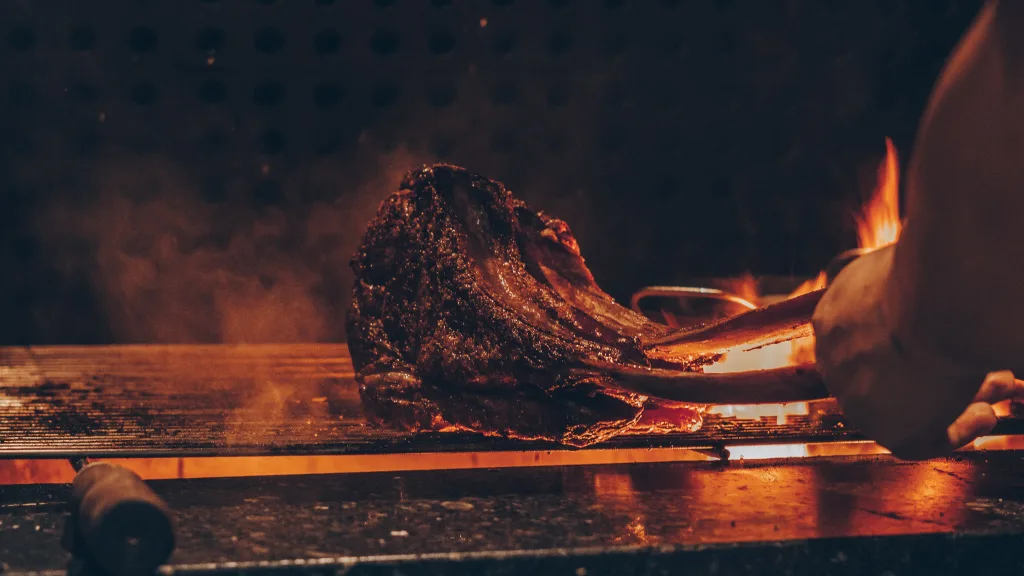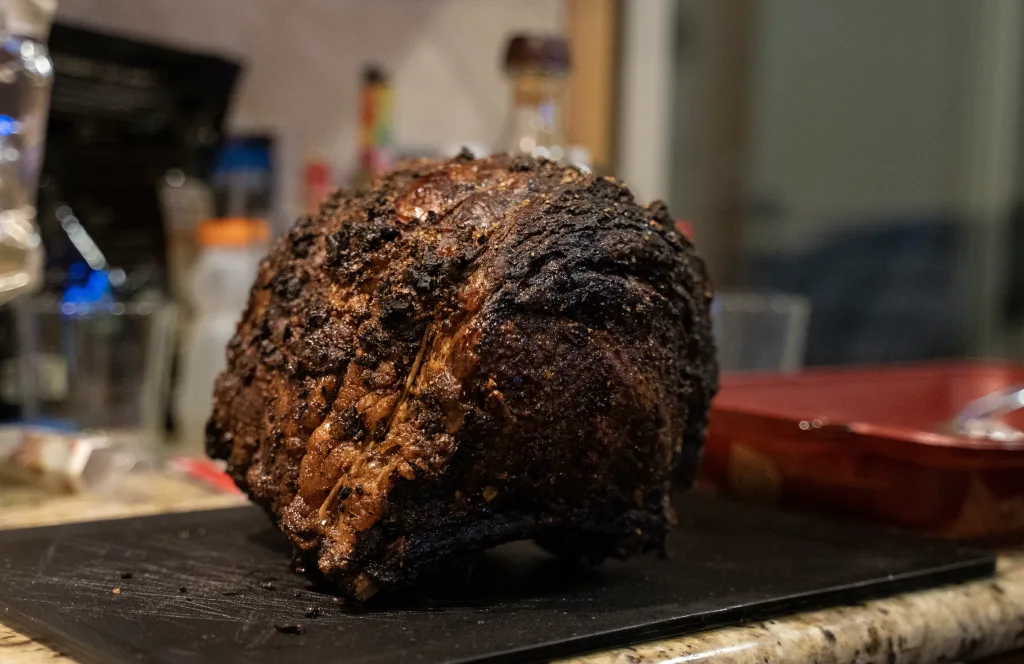When it comes to indulging in a succulent and flavorful steak, few cuts can rival the exquisite taste and tenderness of prime rib. This beloved cut of beef is often associated with special occasions and extravagant feasts, but have you ever wondered where prime rib comes from?
The answer lies in the rib section of the cow, typically between the chuck and the loin. This region is known for its rich marbling and exceptional flavor, making it a prime choice for steak lovers. The prime rib, also referred to as a standing rib roast, is cut from the rib section, specifically the primal rib section. This means that it includes a portion of the bone, which adds to the overall appeal and presentation of the dish.
To better understand the prime rib, it’s important to know that it consists of multiple muscles. These muscles include the longissimus dorsi, also known as the ribeye muscle, which is the primary muscle used in ribeye steaks. This explains why prime rib and ribeye steaks share many similarities in terms of flavor and tenderness.
The prime rib is typically sold as a large, bone-in roast. It is often revered for its impressive size and the impressive amount of meat it yields. This makes it an excellent choice for feeding a crowd or hosting a memorable dinner party. The bone-in roast not only adds flavor but also helps to maintain moisture and tenderness during the cooking process.
When it comes to cooking prime rib, there are several methods that can be employed to achieve the desired result. One popular technique involves searing the meat on high heat to develop a flavorful crust, followed by slow roasting at a lower temperature to ensure even cooking and maximum tenderness. This method allows the fat to render and baste the meat, resulting in a melt-in-your-mouth experience.
Prime rib is often served medium-rare to medium, allowing the natural flavors and juices to shine through. The internal temperature should reach around 130-135°F (54-57°C) for optimal tenderness and flavor. However, cooking times and temperatures may vary depending on personal preferences and the size of the roast.
The beauty of prime rib lies not only in its exceptional taste and tenderness but also in its versatility. While it is commonly enjoyed as a roast, it can also be sliced into thick, juicy steaks known as bone-in ribeye steaks. These steaks are perfect for grilling or pan-searing, offering a charred exterior and a juicy, flavorful interior.
Prime rib is a cut above the rest, originating from the rib section of the cow. Its rich marbling and exceptional flavor make it a favorite among steak enthusiasts. Whether enjoyed as a roast or sliced into steaks, prime rib offers a delectable dining experience that is sure to impress. So, next time you’re in the mood for a truly indulgent meal, consider treating yourself to a mouthwatering prime rib.
Are Prime Rib And Ribeye The Same Thing?
Prime rib and ribeye are not the same thing, although they do come from the same primal cut of beef, which is the rib section. Here are the key differences between prime rib and ribeye:
1. Location: Prime rib is the whole section of beef that runs from the 6th to the 12th rib, while ribeye is a specific steak cut from the prime rib.
2. Bone-in vs. Boneless: Prime rib is typically served bone-in, with the bone adding flavor and moisture to the meat. Ribeye, on the other hand, can be bone-in or boneless, depending on how it is cut.
3. Cooking Method: Prime rib is usually slow-roasted in the oven, which helps to retain its tenderness and juiciness. It is often cooked with the bones still attached to enhance the flavor. Ribeye, on the other hand, is commonly grilled quickly over high heat, resulting in a charred exterior and a juicy, flavorful interior.
4. Thickness: Prime rib is usually cut into thick slices, ranging from 2 to 4 inches, while ribeye steaks are typically cut to a thickness of 1 to 1.5 inches.
5. Presentation: Prime rib is often served as a large roast, with several slices on a plate, making it ideal for family gatherings or special occasions. Ribeye steaks, on the other hand, are individual cuts of meat, perfect for individual servings.
6. Flavor and Texture: Due to the slow-roasting method, prime rib has a more tender and succulent texture. It also tends to have a milder, buttery flavor. Ribeye, on the other hand, has a more robust and beefy taste, with a slightly firmer texture.
While prime rib and ribeye come from the same primal cut, they differ in terms of cooking method, presentation, and flavor. Prime rib is a larger roast, slow-roasted for tenderness, while ribeye is a steak that is quickly grilled for a charred exterior and a juicy interior.

Where Does The Prime Rib Come From A Cow?
The prime rib comes from the ribs of a cow. Specifically, it is cut from the section between the chuck and the loin. This part of the cow is known as the rib section. The ribs are composed of bone and meat, and they are highly sought after for their tenderness and flavor.
The prime rib is a popular cut of beef that is often served as a roast. It is known for its marbling, which adds to its tenderness and juiciness. When cooked properly, the prime rib is incredibly flavorful and has a melt-in-your-mouth texture.
In addition to the prime rib, other cuts of meat that come from the rib section include short ribs, back ribs, and rib eye steak. Each of these cuts has its own unique qualities and can be prepared in different ways.
Here is a breakdown of the different cuts that come from the rib section of a cow:
1. Prime Rib: This is a bone-in roast that is cut from the primal rib section. It is known for its marbling and tenderness, making it a popular choice for special occasions.
2. Rib Eye Steak: Also known as a ribeye or Delmonico steak, this cut is taken from the same area as the prime rib. It is boneless and is highly marbled, resulting in a flavorful and juicy steak.
3. Short Ribs: These are cut from the rib section closer to the belly of the cow. They are typically braised or slow-cooked to achieve a tender and rich flavor.
4. Back Ribs: These are the ribs that are left after the prime rib and short ribs have been removed. They are typically smaller and have less meat compared to other rib cuts. Back ribs are often barbecued or smoked for a delicious and finger-licking experience.
The prime rib comes from the rib section of a cow, specifically the area between the chuck and the loin. This cut is prized for its marbling, tenderness, and flavor. Other cuts that come from this section include rib eye steak, short ribs, and back ribs, each offering its own unique taste and cooking method.
What Cut Of Beef Is Prime Rib Made From?
Prime rib is made from a cut of beef called a standing rib roast. This particular cut is obtained from the rib section of the cow. Standing rib roast is the official name used at the butcher counter when you are shopping for prime rib. It is a popular choice for its tender and flavorful meat.
Which Is Better Ribeye Or Prime Rib?
The question of whether ribeye or prime rib is better is subjective, as it depends on personal preference and the intended use of the cut. Both ribeye and prime rib come from the same section of beef, the rib primal, but they are prepared and served differently.
Here are some key differences between ribeye and prime rib:
1. Cut and Preparation:
– Ribeye: Ribeye is a steak cut from the rib primal, specifically the ribeye muscle. It is typically boneless and has a rich marbling of fat, which contributes to its tenderness and flavor. Ribeye steaks are often grilled, pan-seared, or broiled to achieve a delicious crust on the outside while maintaining a juicy and tender interior.
– Prime Rib: Prime rib refers to a roast cut from the rib primal, consisting of several rib bones and the surrounding meat. It is usually roasted in the oven on low heat, allowing the heat to slowly penetrate the meat and cook it evenly. Prime rib is often served as a large roast, with each slice containing a portion of the bone and the tender, juicy meat.
2. Flavor and Texture:
– Ribeye: The ribeye steak is known for its intense flavor and rich, buttery texture. The marbling of fat throughout the meat adds juiciness and enhances the overall taste. When cooked properly, ribeye steaks offer a tender and succulent eating experience.
– Prime Rib: Prime rib is prized for its tender and juicy meat, with a milder flavor compared to a ribeye steak. The slow roasting process allows the fat to render, resulting in a moist and flavorful roast that is often served medium-rare to medium.
3. Portion Size:
– Ribeye: Ribeye steaks are typically cut into individual portions, making them suitable for single servings. They are often thicker and larger than prime rib slices.
– Prime Rib: Prime rib is usually served as a whole roast, making it ideal for larger gatherings or special occasions. The roast is sliced into individual portions before serving.
4. Cooking Methods:
– Ribeye: Ribeye steaks are versatile and can be cooked using various methods, such as grilling, pan-searing, or broiling. They are often seasoned with simple spices or marinades to enhance the natural flavors.
– Prime Rib: Prime rib is primarily prepared by slow-roasting in the oven. It requires careful monitoring of internal temperature to achieve the desired level of doneness, usually medium-rare or medium.
The choice between ribeye and prime rib depends on personal preference and the occasion. If you prefer a steak with intense flavor and a buttery texture, a ribeye is a great choice. On the other hand, if you’re planning a special gathering and prefer a tender and juicy roast, prime rib would be more suitable. Ultimately, both cuts offer delicious beefy flavors and can be enjoyed in different ways.

Conclusion
Prime rib is a highly coveted and delicious cut of beef that originates from the rib section of the cow. It is renowned for its tenderness, juiciness, and rich flavor. The slow roasting method used to cook prime rib allows it to retain its natural juices and develop a melt-in-your-mouth texture. The marbling of fat within the meat adds to its succulence and depth of flavor. Prime rib is often associated with special occasions and holiday feasts, as it is considered a luxurious and indulgent cut of beef. Whether served rare, medium-rare, or well-done, prime rib is sure to impress even the most discerning meat connoisseurs. Whether enjoyed as a standalone roast or sliced into thick steaks, prime rib is a true delight for meat lovers.
